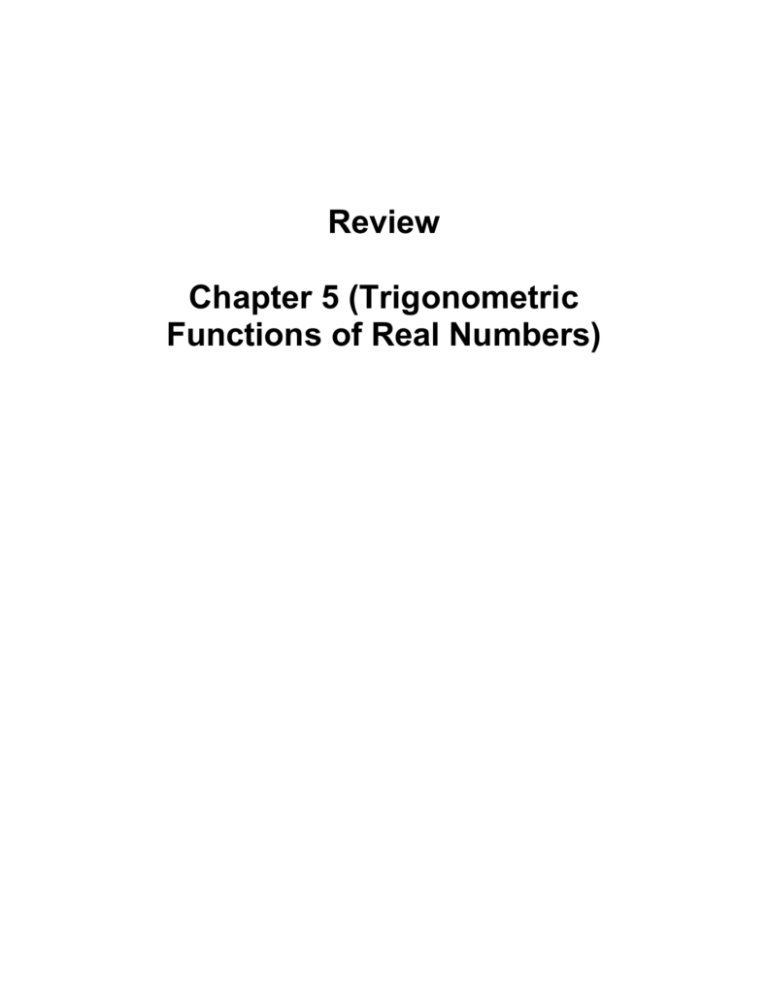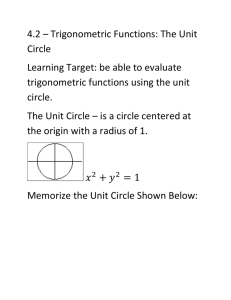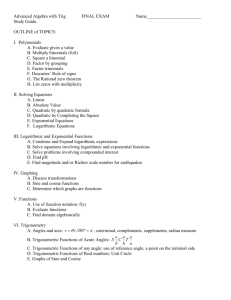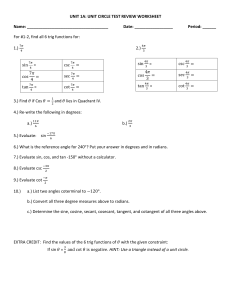Trigonmetric Functions of Real Numbers
advertisement

Review Chapter 5 (Trigonometric Functions of Real Numbers) The Unit Circle: Is the circle of radius 1 centered at the origin in the xy-plane. The equation is: x 2 y 2 1 . *Any point ( x, y ) on the unit circle will satisfy the equation of the unit circle *When given a partial point (x, # ) or (# , y ) you can plug point into equation of the unit circle and find missing x or y value. Examples of Problems with The Unit Circle: 3 1 , on the unit circle. (1) Is the point 2 2 5 , y is on the unit circle in quadrant 4. Find its y(2) The point P 6 coordinate. Radian Measure: If a circle of radius 1 is drawn with the vertex of an angle at its center, then the measure of this angle in radians is the length of the arc that subtends the arc. r r Terminal Points of the Unit Circle: Suppose t is a real number. Lets mark off a distance t along the unit circle, starting at the point (1,0) and moving in a counterclockwise direction if t is positive or in a clockwise direction if t is negative. In this way we arrive at a point P ( x, y ) on the unit circle. The point P ( x, y ) obtained in this way is called the terminal point determined by the real number t . Special Terminal Values: t Terminal point determined by t 0 6 (1,0) 3 1 2 ,2 4 2 2 2 , 2 3 1 3 , 2 2 2 (0,1) Reference Number: let t be a real number. The reference number t associated with t is the shortest distance along the unit circle between the terminal point determined by t and the x axis. a When given t , the reference number is t b b Using the Unit Circle Chart to Find Terminal Points: To find the terminal point P determined by any value of t we use the following steps: a , b 1) Find the reference number t . (Remember t 2a) Depending on the sign of t , move t a time (counterclockwise or clockwise) a You could reduce the fraction of t then follow 2a. b 2b) Examples of Problems with Terminal Points of the Unit Circle: (1) Find the terminal point determined by each given number t : 7 13 5 t t t (a) (b) (c) 6 4 6 101 50 55 t t t (d) (e) (f) 3 4 6 29 55 19 t t t (g) (h) (i) 6 6 4 b ) Trigonometric Functions: Let t be any real number and let P( x, y ) be the terminal point on the unit circle determined by t . We define: y tan t ( x 0) sin t y cos t x x 1 1 hyp x sec t ( x 0) csc t ( y 0) cot t ( y 0) x y opp y (Note pairs of inverses: sin and csc , cos and sec , tan and cot ) Special Values of Trigonometric Functions: t sin t cos t tan t csc t sec t cot t 0 6 4 3 2 0 1 2 0 3 3 ------------ 1 ------------ 2 2 3 3 3 2 2 3 2 1 3 2 2 2 1 2 1 2 2 1 3 2 3 3 2 3 3 1 0 ------------ 1 ------------ 0 (It is most important to know cos t and sin t , the rest can be derived from those) Domains of the Trigonometric Functions: Function Domain sin, cos All real numbers tan, sec cot, csc n for any integer n 2 All real numbers other than n for any integer n All real numbers other than Values of trigonometric Functions: The following diagram shows in which quadrants the trig functions are positive y sin csc All x tan cot cos sec Reciprocal Identities: sin t opp hyp csc t 1 hyp sin t opp cos t adj hyp sec t 1 hyp cos t adj tan t sin t opp cos t adj cot t cos t adj 1 tan t sin t opp Pythagorean Identities: sin 2 t cos 2 t 1 tan 2 t 1 sec 2 t 1 cot 2 t csc 2 t Examples of Problems with Trigonometric Functions: (1) In what quadrant(s) are the following possible: Sec t 0 (Cot t )( Sin t ) 0 (a) (b) Tan t 0 and Cos t 0 ( Sin t )(Cos t )(Tan t ) 0 (c) (d) cos t 0 and cot t 0 (e) (2) Evaluate each of the trigonometric functions: 19 3 23 sin tan sec (a) (b) (c) 4 3 4 7 51 csc tan csc (d) (e) (f) 6 6 4 3 4 (3) The terminal point , determined by a real number t . Find all six trig 5 5 functions. (make sure all fractions are reduced to lowest terms) tan t sin t (4) What is the sign of , in quadrant three? cot t 4 (5) Find the values of all trigonometric functions if cos t and the terminal 5 point of t is in quadrant three. (Make sure all fractions are in lowest terms, all radicals are in simplest radical form and there are no radicals in the denominator) Graphs of Trigonometric Functions: Typical graph of sine: Typical graph of cosine: Trig Functions: The sine and cosine curves and y a sin k ( x b) m y a cos k ( x b) m (k 0) if a value is negative, the graph is reflected over the x axis. a) The number a is called the amplitude and is the largest b) c) d) e) value these functions can obtain. 2 The number is called the period and is the distance k between any two repeating points on the function. Horizontal Shift b , means how far the graph is shifted left or right Vertical Shift m , means how far the graph is shifted up or down An appropriate period on which to graph one complete 2 period is b, b k Examples of Problems with Graphs of Trigonometric Functions: (1) Find the amplitude, period and phase shift of each, also graph one period of the function: 3 2 y 3 sin 2 x y cos 2 x (a) (b) 4 4 3 4 y 2 sin x y 3 cos 2 x (c) (d) 6 3 (won’t have to graph trig function with a phase shift to the left) y a sin( k (t b)) m or y a cos( k (t b)) m Simple Harmonic Motion: Where y represents the displacement of an object after time t , m represents the value of a vertical shift and b represents the value of a horizontal shift. Also: Maximum displacement of the object Amplitude a Period 2 k Frequency Time required to complete one cycle k 2 Number of cycles per unit of time Examples of Problems with Simple Harmonic Motion: (1) Vibrating String: The displacement of a mass suspended by a spring is modeled by the function y 10 sin 4t where y is measured in inches and t seconds. (a) Find the amplitude, period, and frequency of the motion of mass. (b) Sketch the graph of the displacement of the mass. (2) Vibrations of a Musical Note: A tuba player plays the note E and sustains the sound for some time. For a pure E the vibration in pressure from normal air pressure is given by V (t ) .2 sin 80t where V is measured in pounds per square inch and t in seconds. (a) Find the amplitude, period and frequency of V . (b) Sketch a graph of V . (c) If the tuba player increases the loudness of the note, how much does the equation for V change? (d) If the player is playing the note incorrectly and it is a little flat, how does the equation for V change? (3) Modeling a Vibrating String: A mass is suspended from a spring. The spring is compressed a distance of 4 cm and then released. It is 1 observed that the mass returns to the compressed position after 3 seconds. (a) Find a function that models the displacement of the mass. (b) Sketch the graph of the displacement of the mass. (4) Modeling the Bright of a Variable Star: A variable star is one whose brightness alternately increases and decreases. For the variable star Delta Cephei, the time between periods of maximum brightness is 5.4 days. The average brightness (or magnitude) of the star is 4.0, and its brightness varies by 0.35 magnitude. (a) Find a function that models the brightness of Delta Cephei as a function of time. (b) Sketch a graph of the brightness of Delta Cephei as a function of time. Damped Harmonic Motion: If the equation describing the displacement y of an object at time t is ( c 0) y ae ct sin kt or y ae ct cos kt then the object is in damped harmonic motion. The constant c is the 2 damping constant, a is the initial amplitude, and is the period. k Examples of Problems with Damped Harmonic Motion: (1) When a car hits a certain bump on the road, a shock absorber on the car is compressed a distance of 6 in, then released. The shock absorber vibrates in damped harmonic motion with a frequency of 2 cycles per second. The damping constant for this particular shock is 2.8. (a) Find an equation that describes the displacement of the shock absorber from its rest position as a function of time. (Take t 0 to be the instant that the shock absorber is released) (b) How long does it take for the amplitude of the vibration to decrease to 0.5 in.? (2) Two mass-spring systems are experiencing damped harmonic motion, both at 0.5 cycles per second, and both with an initial maximum displacement of 10 cm. The first has a damping constant of 0.5 and the second has a damping constant of 0.1. (a) Find functions of the form g (t ) ae ct cos kt to model the motion in each case. (b) Graph the two functions you found in part (a). How do they differ? (3) A stone is dropped in a calm lake, causing waves to form. The up-anddown motion of a point on the surface of the water is modeled by damped harmonic motion. At some time the amplitude of the wave is measured, 1 and 20 seconds later it is found that the amplitude has dropped to of 10 its value. Find the damping constant c .






